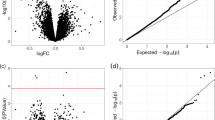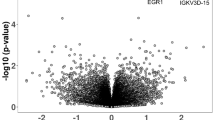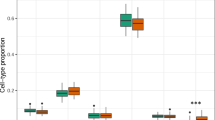Abstract
Autism spectrum disorder (ASD) is one of the most prevalent neurodevelopmental disorders with high heritability, yet a majority of genetic contribution to pathophysiology is not known. Siblings of individuals with ASD are at increased risk for ASD and autistic traits, but the genetic contribution for simplex families is estimated to be less when compared to multiplex families. To explore the genomic (dis-) similarity between proband and unaffected sibling in simplex families, we used genome-wide gene expression profiles of blood from 20 proband-unaffected sibling pairs and 18 unrelated control individuals. The global gene expression profiles of unaffected siblings were more similar to those from probands as they shared genetic and environmental background. A total of 189 genes were significantly differentially expressed between proband-sib pairs (nominal p < 0.01) after controlling for age, sex, and family effects. Probands and siblings were distinguished into two groups by cluster analysis with these genes. Overall, unaffected siblings were equally distant from the centroid of probands and from that of unrelated controls with the differentially expressed genes. Interestingly, five of 20 siblings had gene expression profiles that were more similar to unrelated controls than to their matched probands. In summary, we found a set of genes that distinguished probands from the unaffected siblings, and a subgroup of unaffected siblings who were more similar to probands. The pathways that characterized probands compared to siblings using peripheral blood gene expression profiles were the up-regulation of ribosomal, spliceosomal, and mitochondrial pathways, and the down-regulation of neuroreceptor-ligand, immune response and calcium signaling pathways. Further integrative study with structural genetic variations such as de novo mutations, rare variants, and copy number variations would clarify whether these transcriptomic changes are structural or environmental in origin.




Similar content being viewed by others
References
Luo R et al (2012) Genome-wide transcriptome profiling reveals the functional impact of rare de novo and recurrent CNVs in autism spectrum disorders. Am J Hum Genet 91(1):38–55
Sanders SJ et al (2011) Multiple recurrent de novo CNVs, including duplications of the 7q11.23 Williams syndrome region, are strongly associated with autism. Neuron 70:863–885
Anney R et al (2010) A genome-wide scan for common alleles affecting risk for autism. Hum Mol Genet 19(20):4072–82
Alarcon M et al (2008) Linkage, association, and gene-expression analyses identify CNTNAP2 as an autism-susceptibility gene. Am J Hum Genet 82(1):150–9
Hallmayer J et al (2011) Genetic heritability and shared environmental factors among twin pairs with autism. Arch Gen Psychiatry 68:1095–1102
Ritvo ER et al (1989) The UCLA–University of Utah epidemiologic survey of autism: recurrence risk estimates and genetic counseling. Am J Psychiatry 146(8):1032–6
Chakrabarti S, Fombonne E (2001) Pervasive developmental disorders in preschool children. JAMA 285(24):3093–9
Ozonoff S et al (2011) Recurrence risk for autism spectrum disorders: a Baby Siblings Research Consortium study. Pediatrics 128(3):e488–95
Szatmari P et al (2000) The familial aggregation of the lesser variant in biological and nonbiological relatives of PDD probands: a family history study. J Child Psychol Psychiatry 41(5):579–86
Constantino JN et al (2006) Autistic social impairment in the siblings of children with pervasive developmental disorders. Am J Psychiatry 163(2):294–6
Losh M et al (2008) Defining key features of the broad autism phenotype: a comparison across parents of multiple- and single-incidence autism families. Am J Med Genet B Neuropsychiatr Genet 147B(4):424–33
Sebat J et al (2007) Strong association of de novo copy number mutations with autism. Science 316:445–449
Neale BM et al (2012) Patterns and rates of exonic de novo mutations in autism spectrum disorders. Nature 485:242–245
Pinto D et al (2010) Functional impact of global rare copy number variation in autism spectrum disorders. Nature 466:368–372
Berg JM, Geschwind DH (2012) Autism genetics: searching for specificity and convergence. Genome Biol 13(7):247
Kong SW et al (2012) Characteristics and predictive value of blood transcriptome signature in males with autism spectrum disorders. PLoS One 7(12):e49475
Glatt SJ et al (2012) Blood-based gene expression signatures of infants and toddlers with autism. J Am Acad Child Adolesc Psychiatry 51(9):934–44 e2
Enstrom AM et al (2009) Altered gene expression and function of peripheral blood natural killer cells in children with autism. Brain Behav Immun 23(1):124–33
Hu VW et al (2009) Gene expression profiling differentiates autism case-controls and phenotypic variants of autism spectrum disorders: evidence for circadian rhythm dysfunction in severe autism. Autism Res 2(2):78–97
Hu VW et al (2009) Gene expression profiling of lymphoblasts from autistic and nonaffected sib pairs: altered pathways in neuronal development and steroid biosynthesis. PLoS One 4(6):e5775
Gregg JP et al (2008) Gene expression changes in children with autism. Genomics 91(1):22–9
Nishimura Y et al (2007) Genome-wide expression profiling of lymphoblastoid cell lines distinguishes different forms of autism and reveals shared pathways. Hum Mol Genet 16(14):1682–98
Baron CA et al (2006) Utilization of lymphoblastoid cell lines as a system for the molecular modeling of autism. J Autism Dev Disord 36(8):973–82
Storey JD, Tibshirani R (2003) Statistical significance for genomewide studies. Proc Natl Acad Sci U S A 100(16):9440–5
Schäfer J, Strimmer K (2005) A shrinkage approach to large-scale covariance matrix estimation and implications for functional genomics. Statist Appl Genet Mol Biol 4:(32)
Reich M et al (2006) GenePattern 2.0. Nat Genet 38(5):500–1
Constantino JN et al (2010) Sibling recurrence and the genetic epidemiology of autism. Am J Psychiatry 167(11):1349–56
Kanehisa M et al (2012) KEGG for integration and interpretation of large-scale molecular data sets. Nucleic Acids Res 40(Database issue):D109–14
Levy D et al (2011) Rare de novo and transmitted copy-number variation in autistic spectrum disorders. Neuron 70(5):886–97
Szatmari P et al (2007) Mapping autism risk loci using genetic linkage and chromosomal rearrangements. Nat Genet 39:319–328
Marshall CR et al (2008) Structural variation of chromosomes in autism spectrum disorder. Am J Hum Genet 82:477–488
Vargas DL et al (2005) Neuroglial activation and neuroinflammation in the brain of patients with autism. Ann Neurol 57(1):67–81
Corbett BA et al (2007) A proteomic study of serum from children with autism showing differential expression of apolipoproteins and complement proteins. Mol Psychiatry 12(3):292–306
Garbett K et al (2008) Immune transcriptome alterations in the temporal cortex of subjects with autism. Neurobiol Dis 30(3):303–11
Cross-Disorder Group of the Psychiatric Genomics, C. (2013) Identification of risk loci with shared effects on five major psychiatric disorders: a genome-wide analysis. Lancet
Giulivi C et al (2010) Mitochondrial dysfunction in autism. JAMA 304(21):2389–96
Anitha A et al (2012) Downregulation of the expression of mitochondrial electron transport complex genes in autism brains. Brain Pathol. 23(3):294–302
Chugani DC et al (1999) Evidence of altered energy metabolism in autistic children. Prog Neuropsychopharmacol Biol Psychiatry 23(4):635–41
Minshew NJ et al (1993) A preliminary 31P MRS study of autism: evidence for undersynthesis and increased degradation of brain membranes. Biol Psychiatry 33(11–12):762–73
Acknowledgments
This work was supported by a grant from the Simons Foundation (SFARI 95117 to L.M.K. and I.S.K.), and NIH 5RO1MH085143 to L.M.K. We gratefully acknowledge all the participating families and their contributions. We are grateful to all of the families at the participating Simons Simplex Collection (SSC) sites, as well as the principal investigators (A. Beaudet, R. Bernier, J. Constantino, E. Cook, E. Fombonne, D. Geschwind, R. Goin-Kochel, E. Hanson, D. Grice, A. Klin, D. Ledbetter, C. Lord, C. Martin, D. Martin, R. Maxim, J. Miles, O. Ousley, K. Pelphrey, B. Peterson, J. Piggot, C. Saulnier, M. State, W. Stone, J. Sutcliffe, C. Walsh, Z. Warren, E. Wijsman). We appreciate obtaining access to phenotypic data on SFARI Base. Approved researchers can obtain the SSC population dataset described in this study by applying at https://base.sfari.org. We are grateful to Heather Harris, Katherine Lowe, and coordinators and staff for the recruitment and comprehensive assessment of simplex families and Dr. Ronald Samuels, Jessica Yi, and Rachel Grant for recruiting the control individuals at Boston Children’s Hospital.
Author information
Authors and Affiliations
Corresponding author
Additional information
S.W. Kong and Y. Shimizu-Motohashi contributed equally to this work.
Electronic supplementary material
Below is the link to the electronic supplementary material.
ESM 1
(DOCX 47.1 KB)
Rights and permissions
About this article
Cite this article
Kong, S.W., Shimizu-Motohashi, Y., Campbell, M.G. et al. Peripheral blood gene expression signature differentiates children with autism from unaffected siblings. Neurogenetics 14, 143–152 (2013). https://doi.org/10.1007/s10048-013-0363-z
Received:
Accepted:
Published:
Issue Date:
DOI: https://doi.org/10.1007/s10048-013-0363-z




